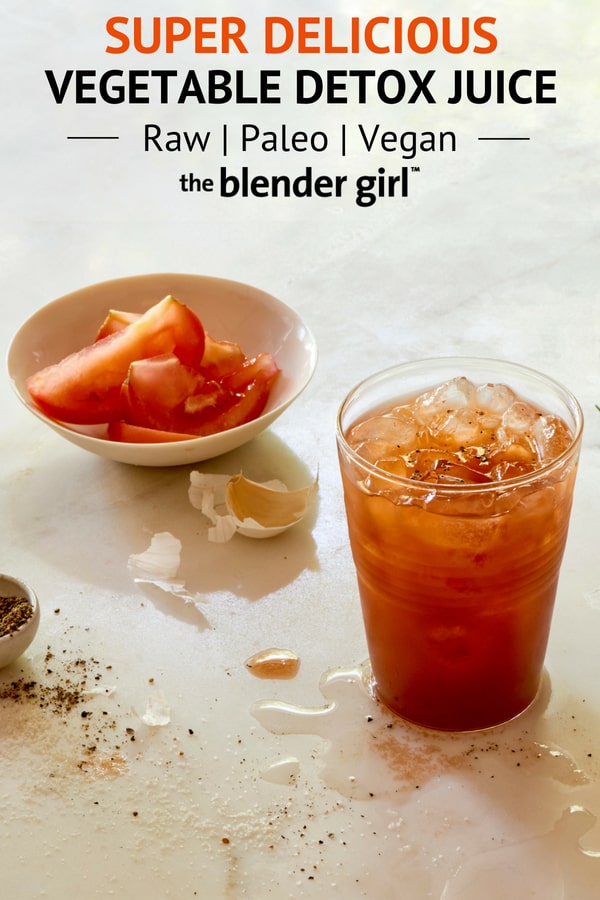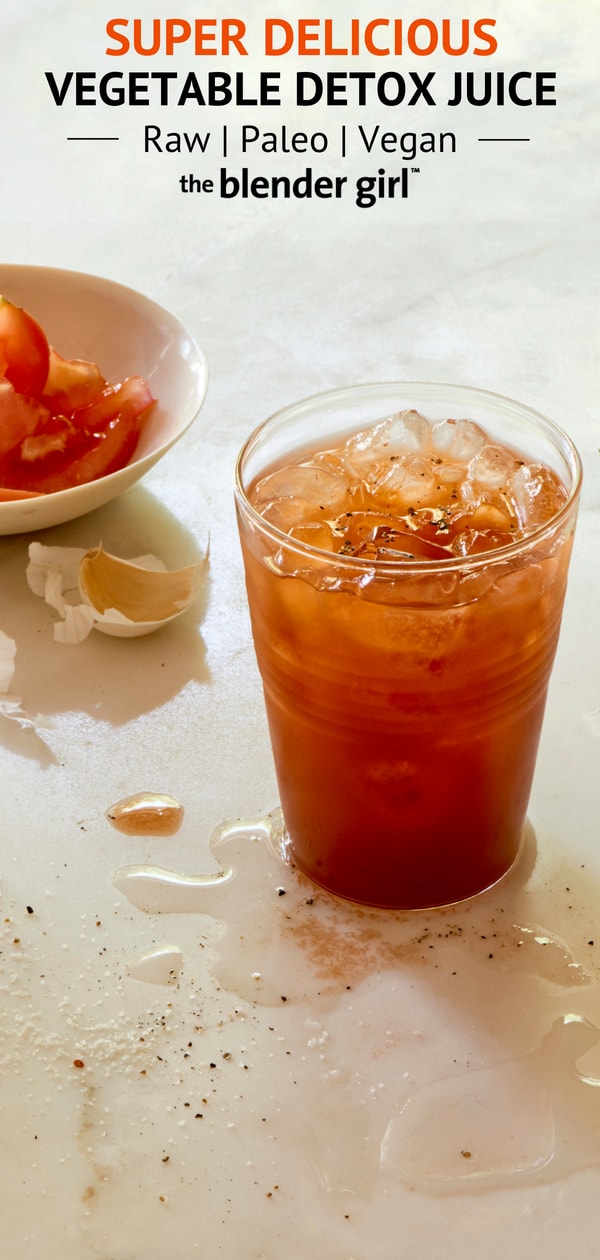Spicy Tomato Vegetable Juice
This spicy tomato vegetable juice is one of my favorite savory vegetable juices because it tastes like a delicious tomato gazpacho, and is loaded with live enzymes, alkaline buffers, essential nutrients, and antioxidants.
The health benefits of tomato juice:
Full of phytonutrients, tomatoes are amped up with antioxidant and anti- inflammatory properties that support the liver, kidneys, bones, blood, and heart, flushing toxins from the liver and gallbladder. High in lycopene, these red warriors combat abnormal cell development, while flavonoids and vitamins A, C, and E fight infection. High levels of vitamin K and potassium help regulate heart rate and blood pressure. Tomatoes are an alkaline fruit that neutralizes acidic build up.
The health benefits of celery juice:
Alkalizing, detoxifying, anti-inflammatory, and loaded with nutrients: essential amino acids, tryptophan, vitamins A, B complex, C, calcium, phosphorus, iron, magnesium, iodine and copper, celery is also effective against respiratory conditions like bronchitis and asthma, and helps lower blood pressure. The organic sodium and potassium in celery make this juice a great post-workout refresher that helps replace electrolytes. It’s also a natural laxative and diuretic, supporting bowel and kidney health. Celery is a cooling vegetable, and we work it into our juices to take advantage of the rich mineral content and natural calming and sedative properties. We like it just as much, though, for its great flavor.
The natural salts are more abundant in the leaves, so when juicing celery, push the entire stalk (leaves and all) through the machine. That will yield a tangier, more savory juice. Celery makes a nice addition to almost any mix, especially juices made with leafy greens and other vegetables. As it sits, celery juice tends to get more assertive flavor-wise, so it’s best enjoyed right after it’s made. If you’re not using immediately, chill it, sealed up, but for no more than a few hours.
The health benefits of kale juice:
With highly absorbable calcium (thanks to a high ratio of calcium to phosphorous) kale juice surpasses milk, cup for cup, in calcium provision. Rich in phyto-chemicals that combat free radicals, kale can lower the risk of colon, breast and lung cancers, as well as fight osteoporosis, macular degeneration, support the cardiovascular and immune systems, and assist in energy production. This mighty leafy green contains lots of chlorophyll, vitamin A (in the form of carotenoids and beta-carotene), vitamins C, E, B6, and K, folic acid, iron, potassium, magnesium, zinc, and sodium.
As a warming vegetable, kale’s a natural for a balancing cooler food. And juicing is a great way to enjoy it in its raw glory, as its flavor is less bitter, relative to that of uncooked kale eaten whole. Still, kale’s kale—which is to say intense; the juice is best blended. It pairs with a wide range of fruits and vegetables, from apple, lemon, carrot and pineapple to tomato, cucumber and melon. Kale makes a good substitute for spinach in any of these juices, but will bring in its slightly bitter sharp note. Juice it stalk and all, and enjoy your new friend with benefits.
The health benefits of parsley juice:
One of the most common herbs, parsley offers a myriad of health benefits. It’s a brilliant blood purifier, and is rich in antioxidants, vitamins and minerals, which help control blood cholesterol, prevent constipation, and protect the body from free-radical damage. Its essential volatile oils can be used as a local anesthetic and as an antiseptic for teeth and gums. Rich in polyphenolic flavonoids, parsley rates among the richest plant sources of antioxidants. It is also a good source of potassium, calcium, manganese, iron, and magnesium, and vitamins A, B, C, E, and K, and folates.
As a warming herb, parsley’s perfect for moderating cooling foods, especially in the colder months. We use the flat-leaf variety, as it has a more intense flavor than its curly-leaf restaurant-garnish cousin, with less bitterness. Light as a feather, parsley will throw its weight around in a juice, delivering that aromatic and pungent “clean” taste. In the right amounts, it combines well with leafy greens, sweet fruits like pineapple and mango, as well as apples, lemons, and limes. A handful juices easily, stems and all.
The health benefits of cilantro juice:
This herb is a health enhancer in an era when heavy-metal toxicity is rampant. Cilantro’s vigorous store of antioxidants makes it one of the most effective foods at flushing that stuff out of our systems. The controversial herb also contains powerful anti-inflammatory agents that ease digestion, nausea, headaches and bloating, and help stabilize blood sugar levels. Cilantro easily gets overpowering in juices. A handful per serving usually does the trick. The entire plant—leaves, stems, and roots—is juice-friendly, the flavor pairing beautifully with pineapple, cucumber, lemon and lime. If you’re not a fan of cilantro, substitute with extra flat-leaf parsley.
The health benefits of carrot juice:
A relative of parsley and celery, carrots contain loads of life-extending carotenes and minerals. This vegetable helps lower cholesterol, too, and alleviates skin conditions like psoriasis and eczema, all while enhancing the respiratory system’s resistance to infection. A great source of vitamin A, carrots also contain the magical antioxidant glutathione, which protects against free radical damage, and B vitamins, potassium, magnesium, and phosphorus. Carrots fuel the production of white blood cells and enhance their performance, and are a great immune booster. These brilliant orange roots also deliver powerful anti-inflammatory agents, helping to relieve the symptoms of rheumatism and arthritis.
Cut off the greens (the jury is still out as to whether they are toxic or beneficial), but don’t peel the roots—much of carrots’ nutrients lie in the skin or just beneath. Just scrub, roughly chop (if using certain masticating juicers) and push through your juicer. The earthy sweet flavor of the juice, much richer than that of carrot itself, combines well with apple, pineapple, beets, tomato, ginger, and cinnamon, so this one works well in both sweet and savory juices.
The health benefits of red bell pepper juice:
Jam-packed with vitamin C and a good amount of vitamin E, these sweet peppers clear respiratory congestion, tackle toxins, and boost collagen to aid skin, bones, and joints.The capsaicin in these sweet peppers speeds up metabolism, and helps regulate blood sugar and cholesterol. The vitamin B6 in bell peppers acts as a diuretic to flush wastes and beat bloating. A truckload of antioxidant phytonutrients and sulfur compounds inhibit abnormal cell growth. Push the pepper, seeds and all through the juicer.
The health benefits of lemon juice:
This alkalizing tart tamer is a potent detoxifier and natural antibiotic that improves liver function, relieves constipation, and can help dissolve kidney and gall stones. High levels of vitamin C help boost immunity and alleviate symptoms of osteoarthritis and rheumatoid arthritis, as well as combat heart disease. Lemons provide calcium and magnesium for strong bones and teeth, along with unique compounds that have powerful antioxidant properties. The flavonoids in lemons have even been shown to halt abnormal cell division.
While lemons are cooling, this superstar can be balanced with warming foods like cayenne and fennel. We use lemons in lots of juice blends to lift the earthy and pungent quality of leafy greens and vegetables, add zip and tang, and balance the acidifying impacts of high-sugar fruits. You may want to remove the rinds of these fruits before juicing, as in substantial quantities they’re slightly toxic, or you may enjoy the zesty punch it adds—a good compromise is a bit of the peel along with the flesh.
The health benefits of juicing garlic:
Loaded up with sulfur compounds—in particular, allicin, which converts to sulfenic acid in the body when digested makes garlic an immunity idol. Rich in alkaline minerals and vitamins, plus essential enzymes, garlic helps the lymph, liver, and colon flush out toxins. Amped up with antibiotic and antiviral ammunition, this crusader supports digestive, respiratory, and heart health, and kills yeast, fungus, intestinal worms, heavy metals, plaque, and mucus congestion. Rich in iron, garlic helps build blood, too. It also adds crazy-amazing flavor to savory juices.
Other Low Sugar Juice Recipes For You
Slumber Tonic Romaine Juice
Alkaline Low Sugar Green Juice
Sleep Elixir Green Juice
Grapefruit Spinach Alkaline Green Juice
Get Healthy With a 3-Day Juice Cleanse
1. DOWNLOAD the FREE 5-Day Energy Boost.
2. START the 3-Day Juice Cleanse.
3. JOIN our Cleanse Facebook group to get support.
Let me know what you think of this recipe in the comments!
Your feedback is important to me, and it helps me decide which recipes to post next for you.











Comments 6
YUM!!!! It’s like drinking salsa! This recipe makes a whopping two really full glasses of deliciousness!
LOL! Yes! It IS like drinking a delicious glass of salsa. I love this juice, and glad you did too xx
Great juice. I want it more. Really really good I can’t wait to make it tomorrow for lunch thank you
If you like gazpacho-style smoothies, this is really a winner! Can’t wait to hear what you think 🙂
Yummmm!!!
Yes, this one is an all-time fave! Glad you enjoyed it too 🙂